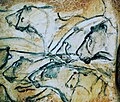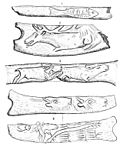 | The Levantine Aurignacian (35,000-29,000 BP, calibrated, 32,000-26,000 BP, non-calibrated) is an Upper Paleolithic culture of the Near-Eastern Levant... 10 KB (882 words) - 14:31, 8 July 2023 |
 | Cro-Magnon (section Aurignacian) produced Upper Palaeolithic cultures, the first major one being the Aurignacian, which was succeeded by the Gravettian by 30,000 years ago. The Gravettian... 150 KB (18,823 words) - 04:43, 8 April 2024 |
Paleolithic Europe (section Aurignacian) followed by the Aurignacian. The origins of this culture can be located in Eastern Europe, in what is now Bulgaria (proto-Aurignacian) and Hungary (first... 22 KB (2,210 words) - 10:13, 22 February 2024 |
frequent than that of the later Aurignacian, while antler tools have not been found. It is followed by the Aurignacian industry. Scholars who question... 14 KB (1,359 words) - 08:25, 13 March 2024 |
 | sculptor. The earliest undisputed examples of sculpture belong to the Aurignacian culture, which was located in Europe and southwest Asia and active at... 37 KB (4,215 words) - 19:59, 21 March 2024 |
 | relates the European Châtelperronian. But the Aurignacian complex (Protoaurignacian and Early Aurignacian) with its famous Cave art seems to correspond... 17 KB (2,052 words) - 02:46, 8 April 2024 |
(BP) and thought to be related to Levantine Emiran and younger European Aurignacian cultures. The word "Ahmarian" was adopted from the archaeological site... 9 KB (873 words) - 12:53, 9 April 2024 |
 | and later the Levantine Aurignacian culture (formerly called Antelian), still of Levalloise tradition but with some Aurignacian influences. According to... 6 KB (548 words) - 13:10, 9 April 2024 |
 | differ greatly from the Aurignacian artifacts. The Kebaran is preceded by the final phase of the Upper Paleolithic Levantine Aurignacian (also known as the... 9 KB (860 words) - 14:03, 14 April 2024 |
Venus of Hohle Fels (category Aurignacian) dated to between 42,000 and 40,000 years ago, belonging to the early Aurignacian, at the very beginning of the Upper Paleolithic, which is associated... 12 KB (1,136 words) - 02:19, 25 February 2024 |
Germany, the artifacts are authentic products of the Aurignacian archaeological culture. The Aurignacian flutes were created between 43,000 and 35,000 years... 8 KB (795 words) - 21:43, 8 February 2024 |
 | as early as c. 300,000–200,000 BP. The main following period is the Aurignacian (c. 43,000–28,000 BP) of Homo sapiens. The culture was named after the... 20 KB (1,787 words) - 00:10, 9 February 2024 |
 | Paleolithic Levantine Aurignacian (formerly called Antelian) period throughout the Levant. By the end of the Levantine Aurignacian, gradual changes took... 23 KB (2,426 words) - 23:44, 3 April 2024 |
Stone tool (section Mode IV: The Aurignacian Industry) were produced in small quantities much earlier by Neanderthals. The Aurignacian culture seems to have been the first to rely largely on blades. The use... 35 KB (3,968 words) - 16:42, 3 March 2024 |
and some of these were similar to the distinctive nosed profile of the Aurignacian burins. Baradost is one of the mountains in the Zagros Mountains in Iraq... 5 KB (489 words) - 10:39, 6 September 2023 |
 | List of Stone Age art (section Aurignacian) sub-categories. The oldest undisputed figurative art appears with the Aurignacian, about 40,000 years ago, which is associated with the earliest presence... 26 KB (2,852 words) - 21:02, 30 March 2024 |
 | Paleolithic Iberia (section Aurignacian) – 11.5 ka ago). The first phase of Aurignacian or Mode 4, sometimes called archaic Aurignacian or proto-Aurignacian, is contemporary with late Châtelperronian... 30 KB (3,602 words) - 14:36, 28 February 2024 |
Crescent: Emiran (50–40 ka) Ahmarian (46–42 ka) Baradostian (36–18 ka) Aurignacian (35–29 ka) Zarzian (20–10 ka) Kebaran (18–12.5 ka) Trialetian (16–8 ka)... 2 KB (166 words) - 21:56, 25 October 2023 |












